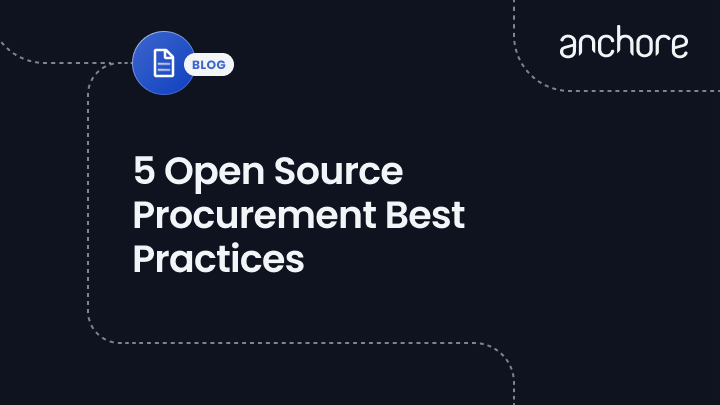SolarWinds and now Codecov point to the need for enterprises to better manage how they procure and intake open source software (OSS) into their DevOps life-cycle. While OSS is “free” it’s not without internal costs as you procure the software and bring it to bear in your enterprise software.
Here are five open source procurement best practices to consider:
1. Establish Ownership over OSS for your organization
Just as OSS is becoming foundational to your software development efforts, shouldn’t it also be to your org chart?
We’re lucky at Anchore to have an open source tools team as part of our engineering group. Our CTO and product management team also have deep roots in the OSS world. Having OSS expertise in our development organization means there is ownership over open source software. These teams serve our overall organization plus current and prospective customers.
You have a couple of options for establishing ownership over OSS for your organization:
- Develop strong relationships with the OSS communities behind the software you plan to integrate into your enterprise software. For example, support can take the form of paying your developers to contribute to the code base. You can also choose to be a corporate sponsor of initiatives and community events.
- Task an appropriate developer or development team to “own” the OSS components they’re integrating into the software they’re developing.
- Stand up a centralized open source team if you have the budget and the business need, and they can serve as your internal OSS experts on security and integration.
These are just a few of the options for establishing ownership. Ultimately, your organization needs to commit the management and developer support to ensure you have the proper tools and frameworks in place to procure OSS securely.
2. Do your research and ask the right questions
Due diligence and research are a necessity when procuring OSS for your enterprise projects. Either your developers or open source team have to take the lead in asking the right questions about OSS projects you plan to include in your enterprise software. Procuring enterprise software requires a lot of work on the part of legal, contracts, and procurement teams to work through the intricacies of contracts, licensing, support, and other related business matters. There’s none of that when you procure OSS. However, it doesn’t mean you shouldn’t put in guard rails to protect your enterprise because sometimes you may not even realize what OSS your developers are deploying to production. Here are some questions that might arise:
- Who’s maintaining the code?
- Will they continue to maintain it as long as we need it?
- Who do we contact if something goes wrong?
It’s not about your developers becoming a shadow procurement department. Rather, it’s putting their skills and experience to work a little differently to perform due diligence they might do when researching enterprise software. The only difference here is your developers need to find out some of the “what ifs” that come if an OSS project goes stagnant or may not deliver on the potential of their project.
3. Set up a Standard OSS Procurement Process
A key step is to set up and document a standard OSS process that’s replicable across your organization to set a standard for the onboarding process. Be sure to tap into the expertise of your IT, DevOps, cybersecurity, risk management, and procurement teams when creating the process.
You also should catalog all OSS that meet the approval process set by your cross-functional team in a database or other central repository. This is a common best practice in some large enterprises, but keeping it up to date comes at an expense.
4. Generate an SBOM for your OSS
OSS doesn’t include a software bill of materials (SBOM), a necessary element for conducting vulnerability scans. It’s up to you to adjust your DevOps processes and put the tools in place for whomever owns OSS in your development organization. Generating an SBOM for OSS can take place at one or more phases in your DevOps toolchain.
5. Put OSS Maintenance in Place
When you’ve adopted an OSS component and integrated it into your software, you still need to have a method in place to maintain that source code. It’s a logical role if you have a dedicated open source team in-house and such work is accounted for in their budget, charter, and staffing. If you don’t have such a team, then the maintenance work would fall to a developer and that risks shifting priorities, especially if your developers are billable to client projects. The last option is to outsource the OSS maintenance to a third party firm or contractor, and that can be easier said than done, as the expertise can be hard to find (and sometimes costly!).
Then again, you can always roll the dice and hope that the OSS project remains on top of maintaining their source code and software with the necessary security updates and patches well into the future.
OSS Procurement and your Enterprise
The time is now to review and improve how your enterprise procures and maintains OSS. Doing the job right requires relationship building with the OSS community plus building internal processes and governance over OSS.
Do you want to generate SBOMs on the OSS in your development projects? Download Syft, our open source CLI tool for generating a Software Bill of Materials (SBOM) from container images and filesystems.



